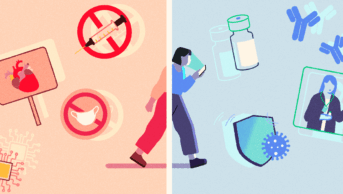We write to outline our concerns that breast cancer prevention strategies are not being implemented to their fullest potential in the UK.
Breast cancer is the most common female cancer and the second leading cause of death in women in the UK. According to Cancer Research UK, there were more than 55,000 new cases of breast cancer and more than 11,000 deaths from breast cancer in 2014[1]
. Each day, 31 British women die of breast cancer[1]
. This grim statistic should persuade British women to protect themselves against this disease. Most breast cancers are oestrogen receptor (ER)-positive, which are targeted successfully with endocrine therapies, such as tamoxifen[2],
[3]
. This medicine binds to the ER and blocks oestrogen-stimulated tumour growth. The translational research and development plan, initiated in the 1970s at Leeds University, has been enormously successful. Millions of breast cancer patients are alive today because of tamoxifen, the first targeted therapy in cancer[4]
. Tamoxifen was also the pioneer medicine as the first preventive for any cancer[2]
.
There are a number of safe, effective and approved agents to protect against breast cancer in women at increased risk[5]
. This medical application is known as chemoprevention[3]
. The standard course of tamoxifen treatment is five years. Remarkably, there is a 50% decrease in breast cancer incidence, not only during treatment, but also for a decade after treatment is stopped. This “carry over” effect means that women continue to be protected from developing breast cancer after treatment stops, but without side effects. Side effects with tamoxifen are rare. Today, side effects are rigorously monitored, whereas 20 years ago this was not the case. Indeed, premenopausal women taking tamoxifen do not have an increase in endometrial cancer, and postmenopausal women without pre-existing endometrial problems are unlikely to experience an increase in endometrial cancer incidence[6]
.
The benefit to the NHS of preventing several thousand new ER-positive breast cancers annually is enormous. If thousands of breast cancer cases are prevented, there will be less strain on the NHS and, more importantly, less strain on the family unit. To put this in perspective, a five-year treatment course of tamoxifen is about £130. By contrast, the treatment of breast cancer per patient can cost £12,000 per year[7]
.
The National Institute for Health and Care Excellence (NICE) issued updated guidelines, which recommend tamoxifen for women at increased risk of breast cancer (moderate-to-high risk). “When exercising their judgement, professionals are expected to take this guideline fully into account, alongside the individual needs, preferences and values of their patients or service users,” NICE advocates on its official website.
The NHS joined forces with NICE in recommending tamoxifen to women at increased risk of breast cancer. The cancer strategy for England (2015–2020) declared its recommendation to British GPs to administer tamoxifen among women at increased risk as an effective strategy of primary prevention.
However, despite these appropriate administrative strides, British GPs lagged behind. A recent study by Smith et al.[8]
demonstrated that half of the 928 GPs who participated in an online survey, did not even know that tamoxifen reduces breast cancer incidence, and three-quarters were not aware of the NICE guideline CG164[9]
. This unfortunate disconnect between medical awareness and appropriate clinical practice costs British women their lives.
We call on the Royal Society of Medicine to renew the commitment to its 2016 agenda ‘Doctors of the future’, whereby it involves professional expertise and initiatives to ensure quality education to British healthcare providers. We also call on British GPs, allied healthcare professionals and British women to champion chemoprevention. No one’s lives should be lost because of a lack of physician education.
Balkees Abderrahman
Postdoctoral fellow
University of Texas MD Anderson Cancer Center
V. Craig Jordan
Fellow, Academy of Medical Sciences
Dallas/Fort Worth living legend chair of cancer research
University of Texas MD Anderson Cancer Center
References
[1] Breast Cancer Research UK. Breast cancer statistics. Available at: http://www.cancerresearchuk.org/health-professional/cancer-statistics/statistics-by-cancer-type/breast-cancer#heading-Two (accessed on 29 March 2017).
[2] Jordan VC. 14th Gaddum memorial lecture. A current view of tamoxifen for the treatment and prevention of breast cancer. Br J Pharmacol 1993;110:507–517. PMCID: PMC2175926
[3] Jordan VC. Tamoxifen (ICI46,474) as a targeted therapy to treat and prevent breast cancer. Br J Pharmacol 2006;147 Suppl 1:S269–276. doi: 10.1038/sj.bjp.0706399
[4] Jordan VC. Tamoxifen: catalyst for the change to targeted therapy. Eur J cancer 2008;44:30–38. doi: 10.1016/j.ejca.2007.11.002
[5] Abderrahman B. Jordan VC. Breast cancer prevention trumps cure. Clini Pharm 2017;9:13. doi: 10.1211/CP.2016.20202048
[6] Jordan VC. The 4Ps of breast cancer chemoprevention: putting proven principles into practice. Cancer Prev Res (2017). In press.
[7] Roberts M. Breast cancer: NHS to offer tamoxifen to at-risk women. 25 June 2013. Available at: http://www.bbc.com/news/health-23032371 (accessed 29 March 2017).
[8] Smith SG, Foy R, McGowan JAet al. Prescribing tamoxifen in primary care for the prevention of breast cancer: a national online survey of GPs’ attitudes. Br J Gen Pract 13 February 2017 doi: 10.3399/bjgp17X689377.
[9] National Institute for Health and Care Excellence. Familial breast cancer: classification, care and managing breast cancer and related risks in people with a family history of breast cancer CG164. 2013. Available at: https://ww.nice.org.uk/guidance/cg164 (accessed 29 March 2017).


